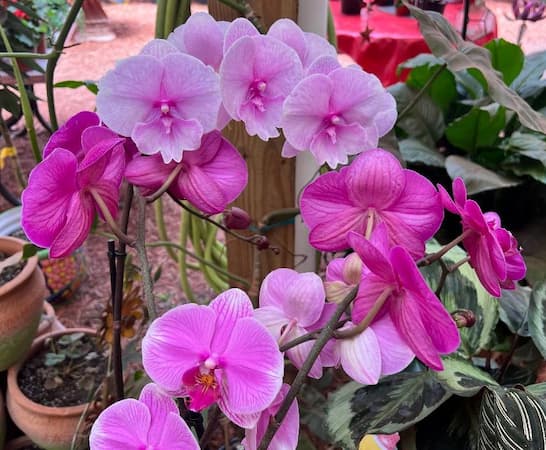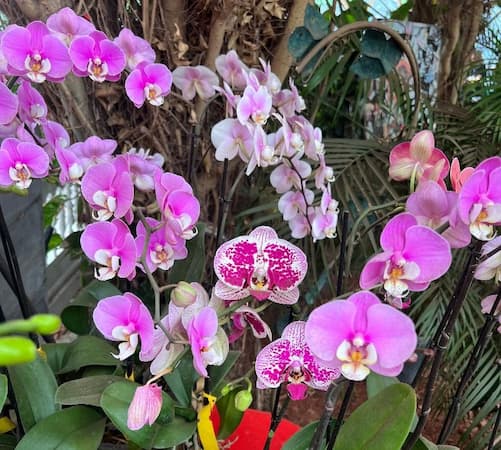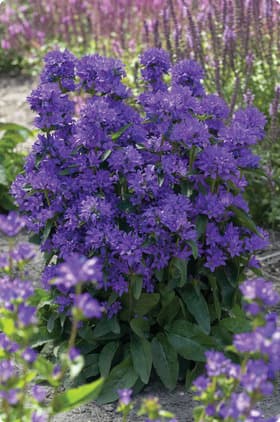How to Grow Orchids

Growing Orchids Perennial Plants Your Home Flower Garden
Growing Orchids indoors or out is fun and easy. They are one of the most popular houseplants. They are an absolutely amazing flowering plant. Orchid plants are native to almost everywhere in the world except Antarctica. With virtually tens of thousands of species, it is the largest family of flowering plants. Tender and beautiful orchid flowers grow upside down in appearance. They come in a wide variety of colors and shades. They have been cultivated for thousands of years. This guide on “how to grow orchid plants” will help you to have beautiful orchids inside your home, or in your flower garden.
Growing Orchid plants indoors is the perfect way to enjoy the hobby of gardening while making the inside of your home more beautiful. Because the plant thrives in partial shade, it is very suitable for growing in the indirect lighting of your home. Outdoors, they are one of a limited number of blooming flower plants that grow well in the partially shaded areas around your yard. They will love being planted on the north side of your home where other flowering plants refuse to grow and bloom. And, you can grow them in planters on a partially shaded patio or balcony.
Most people purchase established plants that florists have coaxed into bloom. It takes 5-7 years after germination for a plant to produce its first bloom.
Orchid Plant Specifications
Flower Colors: Shades of green, orange, pink, purple, white, and yellow.
Flowers Bloom: Varied, may be forced to re-bloom, too.
Plant Height: One to three feet.
Light Requirements: Partial shade, indirect light.
Ideal Soil pH: 4.5 – 5.5.
Hardiness Zone: 5 – 11.
Toxicity: Non-toxic.
Native To: Almost all areas of the world, except Antarctica.
Plant Type: Perennial
Botanical Name: Orchidaceae
Other Names: Boat orchid, corsage orchid, and moth orchid.

Are Orchid Plants Edible
YES!! The flowers and leaves are edible.
Different cultures around the world include orchids in a wide variety of recipes and ways. They are used in salads, soups, dips, and teas. You can decorate cakes, cupcakes, pies, and other desserts with the flowers. They are often used to flavor meats and are mixed with vegetables to add an interesting flavor. Try them in cocktails. Use the flowers and petals as a garnish, too.
Got extra orchids!? They store well in the refrigerator for up to 10 days.
Orchid Plant Medicinal Uses
Orchids have many medicinal uses. It has anticancer, antitumor, antibacterial, antifungal, antioxidant, and anti-inflammatory properties. Here are some of the many medicinal applications:
- Use it to alleviate stomach aches.
- Reduce fevers.
- It relieves headaches.
- Treat infections.
- Use it to relieve rheumatism.
Orchid Trivia
- April 16 is National Orchid Day.
- Ancient Greeks believed the orchid plant had aphrodisiac qualities.
- In ancient cultures, couples hoping to conceive children added orchids to their meals.
- There are an estimated 22,000 to 26,000 species of orchids, representing over 880 genera.
- Some species of this plant can live up to 100 years. Although most have a much shorter lifespan.
- The plants produce the tiniest seeds in the world.
- There can be up to 3 million microscopic seeds in a single seedpod.
- The seeds make up an estimated 6 – 11% of all the seed plants in the world.
- The Grammatophyllum speciosum, also known as the Queen of Orchids, is the world’s largest orchid. The flowers can reach five inches across.
- The smallest orchid flower is the size of a dime.
Light Requirements
Whether grown indoors or out, orchid plants grow best in bright, indirect lighting. A small amount of direct early morning sunlight is okay. And, the plants need bright light to bloom. However, extended direct sunlight, especially in hot weather, will harm the tender flowers.

Orchid Plant Propagation
Orchids can be propagated from seeds. But, almost no one except botanists propagates them from the tiny, microscopic seeds.
Most gardeners and homeowners buy plants from a garden store where they are found in bloom.
You can propagate them by plant division. It is easy to do. Simply, pull up the plant roots. Separate the roots into two or three clumps. Then, repot them or plant them in your garden.

How to Grow Perennial Orchid Plants
In warmer regions, orchids will thrive outdoors in your flower garden. Orchid plants grow best in rich, well-draining acidic soil. Use soil rich in bark and moss. For outdoor plants, you can add a generous amount of compost at the planting site. There is a specially balanced potting soil for growing them as houseplants. Do not plant them deep in the soil. In the wild the plants grow with their roots partially above the level of the soil. The roots like to grab and hold onto bark where it can feed on the nutrients.
Grow orchids in planters with drain holes in the bottom. Water the plants as needed. Allow the soil to completely dry on the surface between watering. Then, water them well.
Fertilize indoor plants with a liquid fertilizer at one-quarter strength every other week. Outdoors, use a general-purpose fertilizer once every two to three weeks during the spring and early summer. Stop fertilizing them in advance of the blooming period. If the buds are not appearing, apply a fertilizer high in phosphorous to stimulate the development of lower buds.
Apply a thick layer of mulch around the base of outdoor plants. It keeps the weeds down and helps to retain soil moisture. And, it feeds the plant as the mulch decomposes.
When buds first appear, move indoor planters to a room that is 55-65° F at night.
After the flower spike grows 5-6 inches, use a plant stake to help hold it up. Lightly, tie or clip the stalk to the plant stake.
In warmer regions of the country, the plant overwinters right in the ground.
How to Prune Orchids
As with any plant, remove any dead, unsightly, or diseased leaves and branches.
It is not necessary to remove spent flowers. However, many people do as the plant will no longer expend energy towards the spent flower and stem. You can cut it off with scissors or remove it by hand. We recommend removing the flower and the flower stem where it meets the main stem (or spike) of the plant.
How to Make Orchids Bloom and Rebloom
Most species of orchids bloom just once a year. The plants need a period of dormancy, usually in the winter, before they bloom again. But with a little effort and a little luck, you might be able to coax them to rebloom. In general, you need to provide it with the normal, ideal growing conditions for orchids. Here’s how:
- After the flowers fall off, cut the main flower spike an inch above a healthy node.
- Place the flowerpot in a warm room between 60-85° F where it can receive bright, indirect sunlight.
- Water the plant after the top of the soil dries off.
- Fertilize it with one quarter-strength liquid fertilizer every two weeks.
- After 6-8 weeks, you should see new leaf growth.
- Then, move the plant at night to a room where the temperature is 55-65° F at night.
- About a month later, a new flower spike will appear.
- Move the plant back into the warm room.
- Now watch as a new flower bud appears and then blooms!
Insects and Plant Disease
A variety of insect pests can infest orchid plants. They include aphids, gnats, mealy bugs, scale, spider mites, thrips, and whiteflies. Use insecticidal soap or neem oil at the first sign of an insect infestation.
Several diseases can harm your plants. Among them are: Root rot in wet soil, fungus, leaf blight, and petal blight. Use a fungicide for bacterial diseases. If a major problem exists, it may be best to discard the plant.
Also see: Plant Problems – causes and cures.
Related Articles
People who like this flower will also like:
Please support our site. Shop for:
- rmmatthews100@hotmail.com
- 585-721-6528
- Rochester, NY
©1999-2024 GardenersNet.Com, All Rights Reserved

